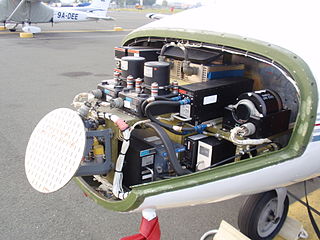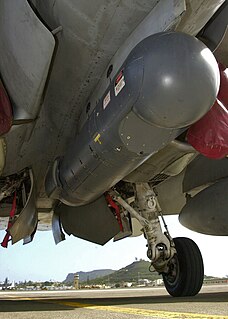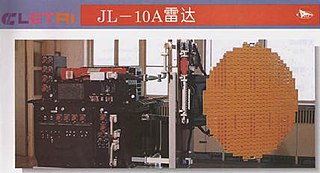
Avionics are the electronic systems used on aircraft. Avionic systems include communications, navigation, the display and management of multiple systems, and the hundreds of systems that are fitted to aircraft to perform individual functions. These can be as simple as a searchlight for a police helicopter or as complicated as the tactical system for an airborne early warning platform.

The McDonnell DouglasF-15E Strike Eagle is an American all-weather multirole strike fighter derived from the McDonnell Douglas F-15 Eagle. The F-15E was designed in the 1980s for long-range, high-speed interdiction without relying on escort or electronic-warfare aircraft. United States Air Force (USAF) F-15E Strike Eagles can be generally distinguished from other US Eagle variants by darker aircraft camouflage, conformal fuel tanks (CFTs) mounted along the engine intake ramps and a tandem-seat cockpit.

LANTIRN is a combined navigation and targeting pod system for use on the United States Air Force fighter aircraft—the F-15E Strike Eagle and F-16 Fighting Falcon. LANTIRN significantly increases the combat effectiveness of these aircraft, allowing them to fly at low altitudes, at night and under-the-weather to attack ground targets with a variety of precision-guided weapons.

The Dassault Mirage 2000N is a variant of the Mirage 2000 designed for nuclear strike. It formed the core of the French air-based strategic nuclear deterrent. The Mirage 2000D is its conventional attack counterpart.

The Lockheed Martin Sniper is a targeting pod for military aircraft that provides positive target identification, autonomous tracking, GPS coordinate generation, and precise weapons guidance from extended standoff ranges.

Targeting pods (TGP) are target designation tools used by attack aircraft for identifying targets and guiding Precision-guided munition (PGM) such as laser-guided bombs to those targets. The first targeting pods were developed in conjunction with the earliest generation of PGMs in the mid-1960s.

The AN/AAQ-28(V) Litening targeting pod is an advanced precision targeting pod system currently operational with a wide variety of aircraft worldwide. The research and development of the Litening was first undertaken by Rafael Advanced Defense Systems' Missiles Division in Israel, with subsequent completion of Litening I for use in the Israeli Air Force.

The CAIC Z-10, also called WZ-10, is a Chinese medium attack helicopter developed for the People's Liberation Army Ground Force. It is designed primarily for anti-tank warfare missions but has secondary air-to-air combat capability as well.
The AN/APQ-174 is an American Ku band radar used on military helicopters for navigation, particularly at low level.
AN/APQ-116 is one of the most numerous terrain-following radars (TFRs) produced in the world, and with over 500 units built, it was a member of a family of TFRs consisted of nearly two dozen models, all of which are based on the same general design principle. First developed by Texas Instruments, and later produced by Raytheon when the latter purchased the radar business of the former.

A radar altimeter (RA), also called a radio altimeter (RALT), electronic altimeter, reflection altimeter, or low-range radio altimeter (LRRA), measures altitude above the terrain presently beneath an aircraft or spacecraft by timing how long it takes a beam of radio waves to travel to ground, reflect, and return to the craft. This type of altimeter provides the distance between the antenna and the ground directly below it, in contrast to a barometric altimeter which provides the distance above a defined vertical datum, usually mean sea level.
Terrain contour matching, or TERCOM, is a navigation system used primarily by cruise missiles. It uses a pre-recorded contour map of the terrain that is compared with measurements made during flight by an on-board radar altimeter. A TERCOM system considerably increases the accuracy of a missile compared with inertial navigation systems (INS). The increased accuracy allows a TERCOM-equipped missile to fly closer to obstacles and generally lower altitudes, making it harder to detect by ground radar.

The JL-10A airborne radar is a highly digitized pulse-Doppler radar with slotted planar array developed for the People's Liberation Army Air Force (PLAAF) as a replacement for the older Type 232H radar currently employed by the Chinese air force. The radar is built to MIL-STD-1553 standard so it is compatible with western electronics and weaponry. Originally, the radar is capable of simultaneously tracking 10 targets and engaging 2 of the 10 tracked when using semi-active radar homing air-to-air missiles, or 4 of the 10 tracked when using active radar homing air-to-air missiles.

The Sukhoi Su-30MKK is a modification of the Sukhoi Su-30, incorporating advanced technology from the Sukhoi Su-35 variant. The Su-30MKK was developed by Sukhoi in 1997, as a result of a direct Request for tender between the Russian Federation and China. It is a heavy class, all-weather, long-range strike fighter, and like the Sukhoi Su-30, comparable to the American McDonnell Douglas F-15E Strike Eagle. Su-30MK2 is a further improvement to Su-30MKK with upgraded avionics and maritime strike capabilities. The MKK and MK2 are currently operated by the People's Liberation Army Air Force, Indonesian Air Force, Vietnam People's Air Force, Venezuelan Air Force and the Ugandan Air Force.

The C-704 is a Chinese anti-ship missile. The missile was developed by the third research institute of the Chinese Aerospace Group, also the manufacturer of the C-701.
TY-90 is a Chinese air-to-air missile specifically developed for attack helicopter dogfights. Contrary to the erroneous claims, the missile is not developed from MANPADS missiles, but instead, it is specifically designed as an air-to-air missile from to engage in helicopter combat.
FILAT pod is an airborne targeting pod designed to provide aircraft with all weather / night attack capabilities. It was first revealed to the public at 1998 Zhuhai Air Show, and it is designed by the 613 Institute of AVIC.
The PS-05/A is a pulse-doppler radar currently used by the JAS 39 Gripen fighter aircraft. It weighs 156 kg and was developed by Ericsson in collaboration with GEC-Marconi, sharing some technology with the latter's Blue Vixen radar for the Sea Harrier.
The DK-10, also known as the Sky Dragon 50, is a surface-to-air missile system developed by Chinese arms manufacturer Norinco. It was designed to be a competitor to the HQ-16 (LY-80), but has not been adopted by the People's Liberation Army for service as the HQ-16 has been preferred. Instead, it has been exported for use by foreign armed forces.











